Tactical missile system 2K4 "Filin"
By the end of the forties, it became clear that future progress in the field of nuclear weapons would allow the use of such weapon not only as strategic weapons aviation. Surveys began in some new directions, including in the field of missile weapons for the ground forces. The first studies in this area showed the practical possibility of creating self-propelled systems with ballistic missiles having a firing range of several tens of kilometers and capable of carrying a special warhead.
In the early fifties, a new proposal was approved by the customer in the person of the Ministry of Defense, after which the Soviet industry began to develop new projects. The first models of domestic development tactical missile systems were to be the 2K1 Mars and 2K4 Filin systems. NII-1 (now the Moscow Institute of Thermal Engineering) was appointed the lead developer of both projects. The main designer of "Mars" and "Filina" became N.P. Mazurov. Both samples of the technique should be submitted for testing in the middle of the decade. By the 1958-60 years they were planned to be adopted.
In the early stages of the project "Filin", it was decided to use the original composition of the complex, which differs from the "Mars" system. Initially, the complex was proposed to include a self-propelled launcher 2P4 "Tulip", several types of missiles, as well as a mobile repair and technical base. The task of the latter was the transportation of missiles and combat units, as well as the installation of ammunition on combat vehicles. Subsequently, views on the composition of the auxiliary technology have changed. In addition, it was decided to develop a new version of the repair and technical base, but full-fledged work on this project began later as part of the creation of the Luna complex.
One of the main elements of the 2K4 “Filin” complex was the self-propelled 2P4 “Tulip” launcher. The development of this machine was entrusted to SKB-2 of the Leningrad Kirov Plant, the works were supervised by K.N. Ilyin. In order to speed up the development and simplify production, the mass-produced self-propelled gun ISU-2K was chosen as the base for the installation of the 4P152. From the existing chassis, it was proposed to remove all unnecessary units, instead of which it was necessary to install a large wheelhouse of complex shape, as well as various details of the launcher.
In the course of processing by the new project, the base ACS chassis retained the B-2IS diesel engine with a capacity of 520 hp. The original parts of the body of self-propelled guns were made of rolled armor and had a thickness of up to 90 mm. The new wheelhouse, necessary for the accommodation of the crew and control equipment, was distinguished by less powerful protection. The undercarriage of the base chassis remained unchanged. She had six road wheels with a torsion bar on each side. In view of the preservation of the classical layout of the hull, despite the re-equipment, the drive wheels of the tracks were placed in the rear of the hull.
Instead of the upper part of the hull and the fighting compartment on the existing chassis, a new wheelhouse was mounted with inclined frontal and side plates, as well as a cutout in the central part of the roof, intended for the transport of the rocket. Inside the felling site was provided for the installation of various equipment. In addition, there were places for a crew of five. For access to the cabin there were large doors on the sides. The crew could use various glazing elements to observe the situation. For example, two large windows were placed in front of the driver’s workplace.
On the front side of the cabin, the lattice protection of the rocket was attached, made in the form of an open-top conical assembly. With its help, the head of the rocket was supposed to defend against possible strikes while the self-propelled launcher was moving. In the transport position, the launcher of the Tulip machine was in the upper chute of the cabin, and the protruding head of the rocket was above the lattice protection.
On the stern of the hull armored 2P4 proposed to mount two supports for the rocking launcher. The entire rear part of the roof of the case was given for the installation of other special equipment. Thus, directly behind the aft cabin, hydraulic cylinders were mounted to raise the launcher to the required position. Also on the roof provided space for the installation of various equipment of one purpose or another. Outrigger jacks were mounted below the launcher supports on the stern sheet. They could swing on horizontal axes, and in preparation for the shooting they sank to the ground, holding the body of the machine in the required position.
A special launcher was developed for transporting and launching missiles of all compatible types. Its main element was a cylindrical guide casing accommodating one rocket. The cylindrical guide was made in the form of two detachable parts. The lower one was mounted on a rocking base, and the upper one was hinged on it. To reload the launcher, the top of the guide could fold to the side. After installing the rocket, she returned to the site, allowing the continuation of combat work. Inside the cylindrical unit there was a screw runner used for the initial promotion of the rocket at launch.
The rear part of the guide was connected to a solid box-shaped structure, which, in turn, was mounted on the hull aft hinge. Such a system allowed to raise the guide to the desired angle of elevation. Horizontal guidance using launcher devices was not provided. To set the correct direction to the target, it was necessary to turn the entire combat vehicle.
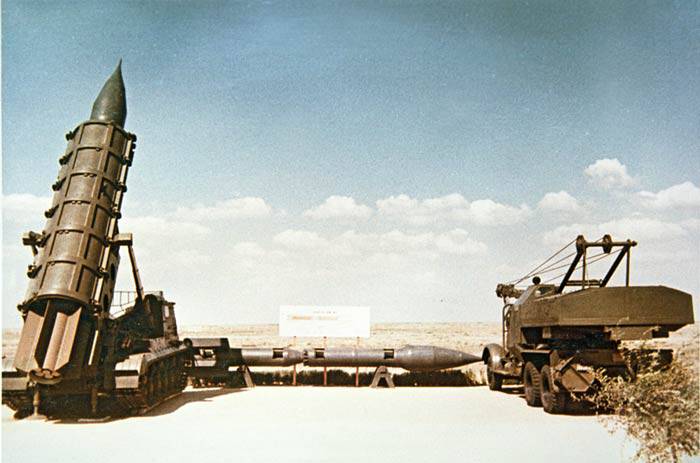
Self-propelled launcher, rocket and crane during the demonstration of the complex "Filin" to the customer. Photo Militaryrussia.ru
The self-propelled launcher had a length of 9,33 m, a width of 3,07 m and a height of 3 m. With the missile installed, the machine had a combat weight of 40 tons. The 520-strong engine allowed to drive on the highway without a rocket at speeds up to 40-42 km / h. After installing the ammunition, the maximum speed was reduced to 30 km / h. Power reserve exceeded 300 km.
As part of the 2K4 project, “Filin” developed three versions of unguided single-stage ballistic missiles. The 3P2, 3P3 and 3P4 products had a similar design and used some common units, however, they differed in combat equipment and a number of characteristics. Missiles of all types had a cylindrical body of large elongation with a diameter of 612 mm. In the head part of the body there were fastenings for mounting the over-caliber warhead. Inside the case was placed solid engine. The tail of the rocket received a set of stabilizers. In the case of the 3P2, a stabilizer with six planes was used. Other missiles had four or six planes. The total length of all missiles for the “Filina” was within 10,354-10,378 m. The span of the stabilizer reached 1,26 m. The launch weight is up to 4,94 t.
As in the case of the 3P1 rocket for the 2K1 Mars complex, it was decided to use a two-chamber solid propellant engine. The cameras were equipped with charges of ballistic powder NFM-2, flammable at the same time. The head camera had 12 nozzles tilted 15 ° away from the body. In addition, an 3-degree inclination with respect to the course plane was envisaged, designed to give the rocket rotation. The tail chamber had a different nozzle apparatus with seven parallel nozzles. The total mass of the solid fuel of both chambers was 1,642 t. For its complete combustion, under normal conditions, 4,8 c was required. The active site had a length of 1,7 km. The maximum speed of the rocket reached 686 m / s.
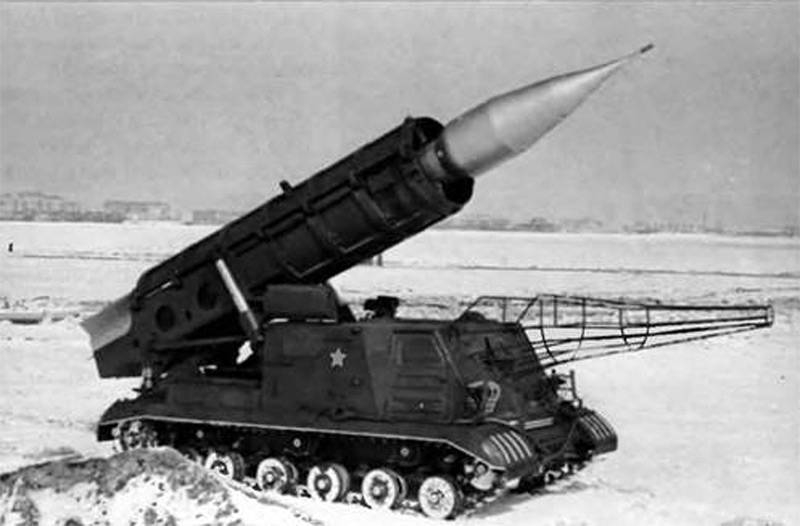
In firing position. Photo Militatyrussia.ru
The 3P2 ballistic missile was to be equipped with a special warhead placed in a hull with a diameter of 850 mm. The charge for this warhead was developed based on the RDS-1 product. The design was carried out in KB-11 under the guidance of Yu.B. Khariton and S.G. Kocharyants. The mass of the warhead of the 3Р2 missile was 1,2 tons. The power of the warhead is 10 CT. A characteristic feature of this rocket was a stabilizer consisting of six planes. Other products of the family used means to stabilize a different design, which was associated with the parameters of the head section.
The project 3P3 was developed non-nuclear warhead. In the over-caliber case of such a warhead a high-explosive charge with a weight of 500 kg was placed. The total mass of the conventional warhead was 565 kg. The low weight of the combat equipment led to the need for some changes in the design of the stabilizer.
The rocket 3Р4 was a product of unification of existing products. It was proposed to mount a special warhead borrowed from the 3P2 rocket of the 3K1 "Mars" complex on the body with the 2Р1 engine. An interesting difference between the 3P4 and the other ammunition of the Filin system was the smaller diameter of the head part in comparison with the diameter of the rest of the body.
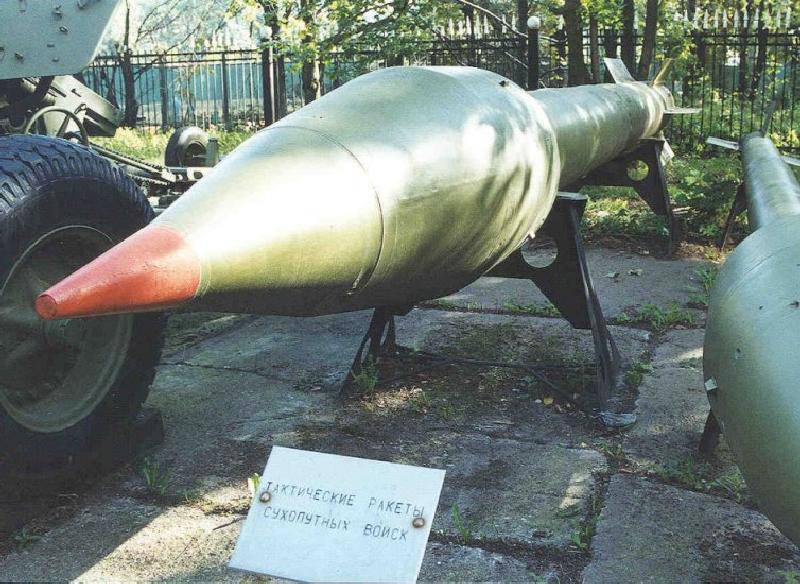
Mockup of the 3P2 rocket. Photo Russianarms.ru
Arriving at the specified firing position, the 2P4 self-propelled launcher was to carry out the procedure for preparing for shooting. The crew of five people was given 30 minutes to perform all such work. The crew had to determine its own location, and then set the launcher in the direction of the target. When performing these procedures, it was necessary to use both the navigation equipment of the launcher and the meteorological system “Sample”, which includes weather probes. The guidance in range was carried out by changing the elevation angle of the guide.
After receiving the launch command, two solid fuel charges were ignited at the same time, which led to the creation of thrust and immediately from the rail. Stabilization of all types of rockets was carried out using oblique head-chamber nozzles and stabilizers fixed at an angle to the product's longitudinal axis. The firing range could vary from 20 km to 25,7 km. In this case, in some foreign sources, the range to 30-32 km is mentioned. The circular deviation of the unguided rocket reached 1 km, which could place special demands on the power of the warhead.
After firing, the Tulip self-propelled launcher was supposed to leave the firing position. On a pre-prepared site could be reloaded launcher. In this procedure, it was necessary to use transporters of rockets based on wheel tractors and a K-104 type truck crane on the YAZ-210 three-axle chassis. With the help of auxiliary equipment and its crews, the calculation of the 2K4 complex "Filin" could install a new rocket and again move forward to the firing position. The recharge was set to 60 minutes.
In 1955, SRI-1 completed work on the first version of the rocket for the Filin. In the same year, the first 3P2 products were manufactured, which soon went to the testing ground. The first checks of the new missiles, including the 3P3 and 3P4 types, were carried out using a stationary launcher similar to that proposed for mounting on a self-propelled chassis. In the final stages of testing involved full-fledged combat vehicles with a full range of equipment.
For a number of reasons, the first samples of self-propelled installations 2P4 "Tulip" were made only in 1957 year. Soon after the completion of construction and factory tests, the experimental equipment was sent to the landfill for subsequent inspections along with the rockets. The first launches of the 3P2 family of rockets with a standard self-propelled launcher took place before the end of the 1957 year. Due to the lack of claims to the finished equipment, the customer ordered to start mass production of launchers before the end of all the necessary checks.
Until the end of 1957, the Kirov plant was able to build 10 2P4 machines, including prototypes. Over the next 58 year, the company also supplied 26 Tulip products. After that, the assembly of new technology was stopped. In just a few months of serial production of the Filin complexes, the army received only 36 launchers, several dozen auxiliary machines and a certain number of three types of ballistic missiles.
After completion of the ground tests, which lasted until 1958, the newest tactical missile system 2K4 "Filin" was put into trial operation. 17 of August of the same year issued a decree of the Council of Ministers of the USSR, according to which the system "Filin" was officially accepted for supply. In this case, for some reason, it was decided not to transfer such equipment to the combat troops of the missile forces and artillery.
The operation of the 2K4 “Filin” complexes mainly consisted in the development of new equipment by personnel and participation in various combat training activities. In addition, since 7 November 1957, self-propelled missile launchers regularly participated in parades on Red Square. Despite the small number, the "Owls" formed full-fledged parade calculations, capable of giving their people confidence in safety, as well as cool the hot heads of foreign "war instigators". According to reports, the Filin complexes participated in Moscow parades until the very end of their operation.
By the end of the fifties or the beginning of the sixties, there is a curious case of the participation of the missile complex in exercises with the actual use of special combat units. According to the recollections of the participants in these events, during the launch of the 3P2 family of rocket with a special combat unit for the training target, there were problems with the operation of automation. The radio altimeter of the warhead, designed to determine the height of the charge detonation, did not work properly. Because of this, the explosion occurred outside the settlement area of the landfill. This incident could be the reason that the serial "Filins" did not enter the combat units of the ground forces.
29 December 1959, the year The Council decided to start mass production of the latest tactical missile systems 2K6 "Luna". The following year, the army received the first five systems of this type, as well as rockets for them. The Luna complex differed from the previous systems of the Mars and Filin types with higher characteristics, and also had some advantages in the form of a wider range of ammunition, etc. In connection with the advent of the new missile system, which has significant advantages over the existing ones, further production of the latter was no longer considered necessary.
In February, 1960 was decided to terminate the operation of the 2-4 Filin complexes. Machines were decommissioned and sent to storage. Missiles for them were also written off and left for recycling. Due to the small amount of built equipment, decommissioning and cutting did not take much time. All the work that followed the abandonment of "Filin", took just a couple of years.
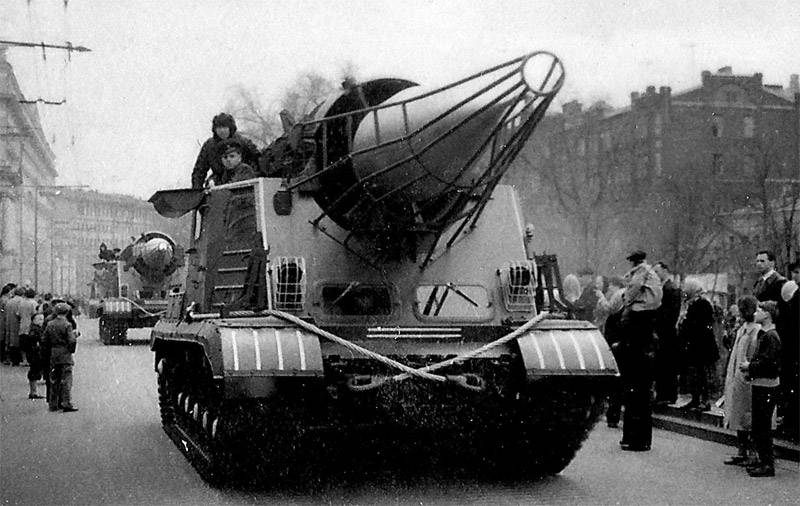
On the streets of Moscow. Photo Militaryrussia.ru
Most of the self-propelled launchers 2P4 "Tulip" was dismantled as useless. Nevertheless, some machines from 36 built managed to avoid a similar sad fate. At least one such armored vehicle has survived to our time due to the fact that it had previously become a museum exhibit. Now this sample of technology, together with a mock-up of an unguided rocket, is being demonstrated in one of the halls of the Military History Museum of Artillery, Engineering Troops and Communication Troops (St. Petersburg). In addition, there is information about the availability of models of 3P2 family of rockets in other domestic and foreign museums.
The tactical missile system 2K4 "Filin" with unguided ballistic missiles 3Р2, 3Р3 and 3Р4 was one of the first domestic developments of its class. Like some other early representatives of promising areas, this complex was not distinguished by high performance, and was also not built in large quantities. Nevertheless, the development, testing and short-term operation of the Filin complex allowed the specialists of the Soviet defense industry to gain the experience necessary to create new such projects. Already in the late fifties in the field of tactical missile systems there was a real breakthrough in the form of the 2K6 "Luna" system, which could hardly have appeared without previous developments - 2К1 "Mars" and 2К4 "Filin".
Based on:
http://dogswar.ru/
http://russianarms.ru/
http://rbase.new-factoria.ru/
http://militaryrussia.ru/blog/index-241.html
Shirokorad A.B. Atomic ram of the twentieth century. - M., Veche, 2005.
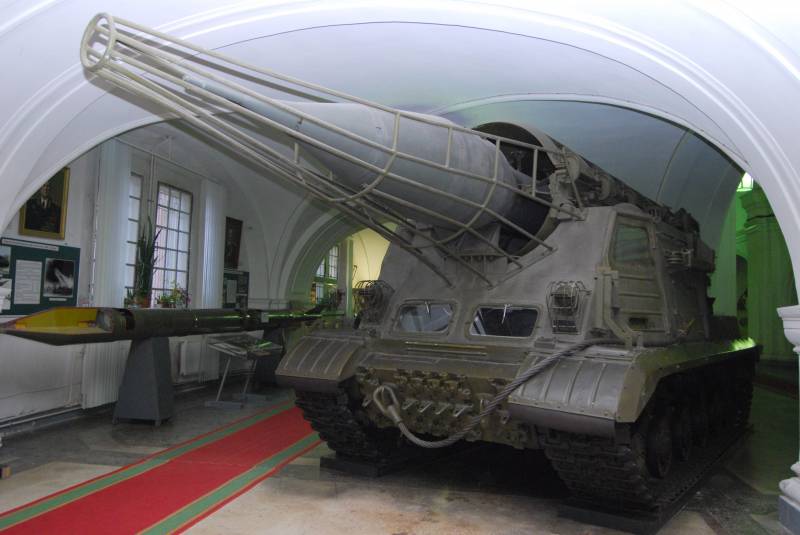
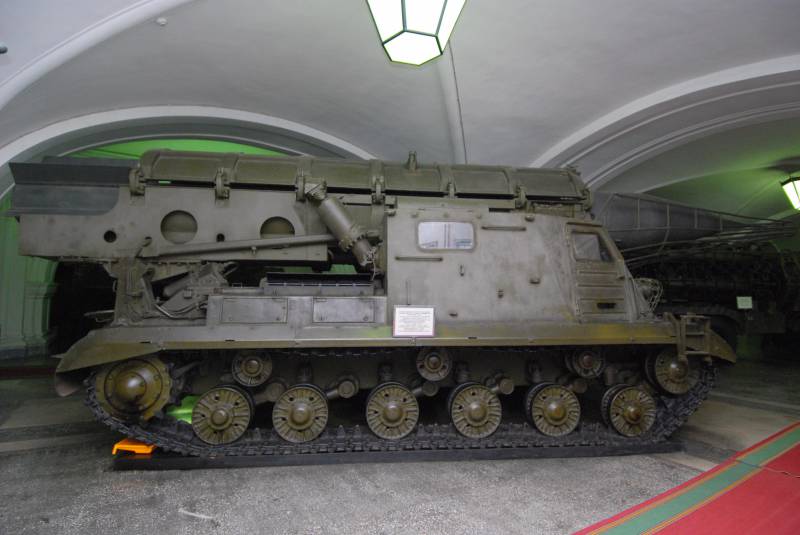
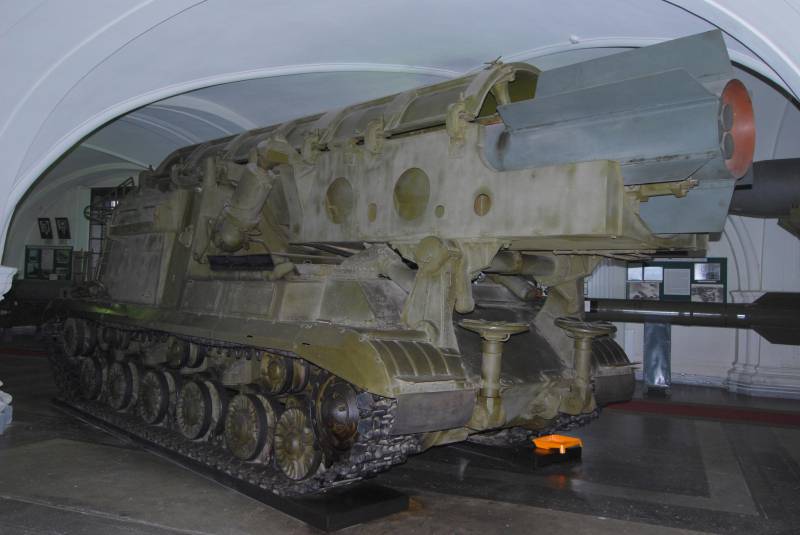
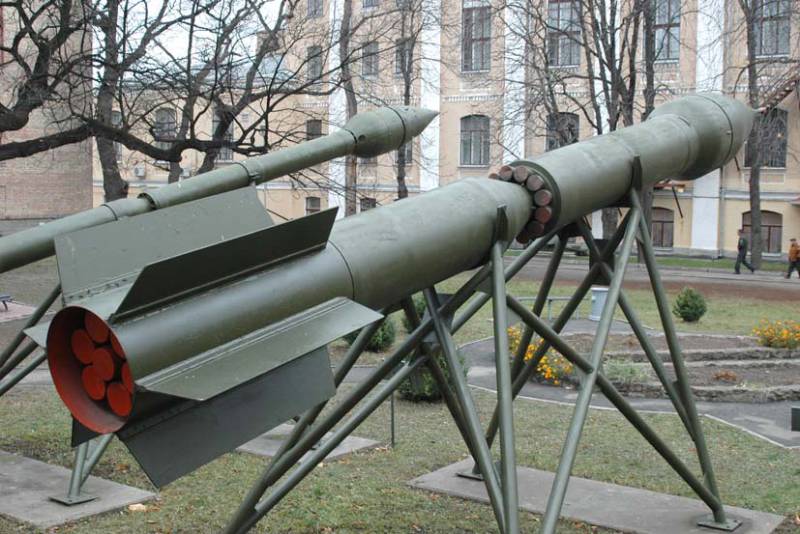
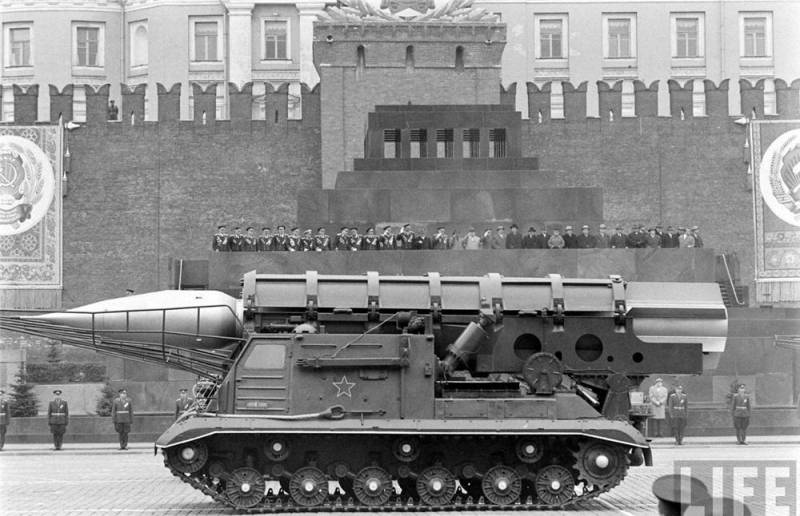
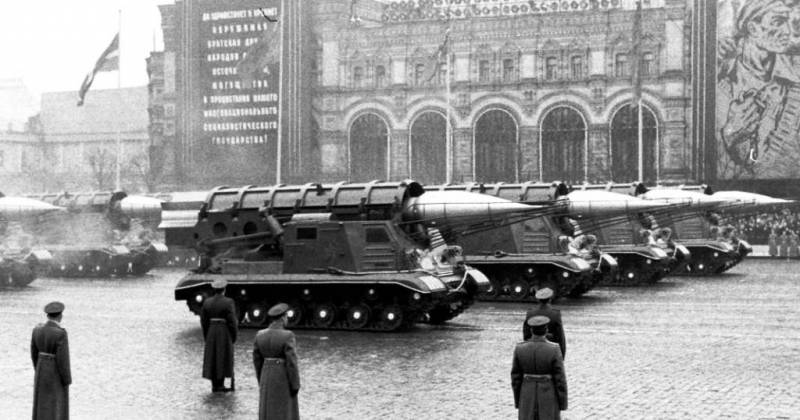
Information